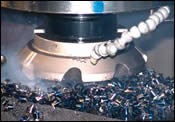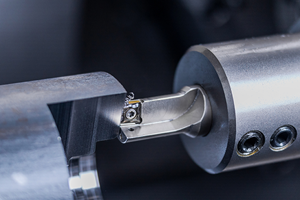Tangential Milling Helps Foundry Speed Operations While Reducing Costs
There are always exceptions to those 'hard and fast' machining rules. A tripling of edge life and a 3-to-1 reduction in cutter count on a tough-cast steel milling job at Harrison Steel Castings Company (Attica, Indiana) proves this.
There are always exceptions to those "hard and fast" machining rules. A tripling of edge life and a 3-to-1 reduction in cutter count on a tough-cast steel milling job at Harrison Steel Castings Company (Attica, Indiana) proves this.
"For heavy roughing cuts, conventional wisdom calls for round or "button" inserts because of their stronger insert geometry," says Anthony Stanley, an Ingersoll Cutting Tools (Rockford, Illinois) application engineer, "but here, a big rectangular insert comes out on top." With the tooling switch at the full-service iron and steel foundry, a single cutter now does a job that once required three.
The key to the company's "double-triple" gain is tangential milling. The inserts lie flat around the cutter's periphery, rather than conventionally. Re-orienting the insert aligns the stronger insert axis with the main cutting-force vector.
"Picture a matchstick clamped to the edge of a table with a little bit protruding above the surface," says Mr. Stanley. "Now take a horizontal swipe at it. That unsupported protruding part snaps off because the cross section facing the brunt of the shear and bending forces is so small. However, if you lay the match down on the tabletop and clamp it, you can strike it the same way and it won't break. The match survives because the force of the blow is absorbed by the entire axial cross section of the match."
Ingersoll Cutting Tools pioneered the tangential milling concept in the 1960s. The company recently redefined its tangential milling family by incorporating a new technology referred to as "IngersollMaxline." A recent incarnation of this technology is S-Max, which encompasses face milling, slab milling and slotting applications.
The job at Harrison involved roughing and finish-milling two mounting pads on a 1 1/2-ton cast steel bulldozer frame. Each pad measures 500 square inches and requires milling off about 5/8 inch of material. As is normally the case with steel castings, the first pass is the most taxing because of the inevitable surface oxides and inclusions.
Face milling the frames, which consisted of three roughing and two finishing passes, was accomplished on a Versatech V-60 vertical CNC mill from Mazak Corp. (Florence, Kentucky). Harrison notes that it previously had to switch edges after each pass—four indexes per part—and that three separate cutters were required, one for roughing and one each for the two finishing passes. The roughing cutter at the time was a 6-inch, eight-insert face mill using round or "button" inserts. The inserts were oriented conventionally, their long axes in line with a cutter radius. With that particular cutter, according to the company, the total cycle time averages 1 hour.
"This job was always high on our list of priorities," says J.D. Gray, process control coordinator at Harrison. "When a tool salesman offers a trial with a ‘new, improved' cutter, we apply the product to this job for two reasons. Foremost, we want to fix the job. Another motive is that we get a quick assessment of the new cutter; this job has taken its toll on a good deal of cutters."
In fact, the company says it averaged one ruined cutter or blown pocket per week in milling these frames. An edge would go dull immediately. Before the worker could react, the inserts were plowing rather than cutting the metal. Cutting forces escalated instantaneously, overloading a cutter pocket or the entire cutter. Replacing the cutters was quite expensive. The operation also posed a safety hazard because of the cutter shrapnel. Every time a cutter pocket was replaced, the tool setter had to perform the tool setting sequence for the entire cutter (to bring all the round inserts into identical position with respect to data).
One day, Mr. Stanley visited Harrison. With the new S-Max face mill in hand, he was ready for a challenge. Featuring a tangential milling insert orientation, large rectangular inserts, an IN2005 carbide grade and a 45-degree lead angle, the face mill appeared promising. Using identical settings, Mr. Gray loaded it on the CNC mill for the usual trial run.
Despite the surface scale on the workpiece, the first roughing pass went well. So did the second, and then the semi-finish and finishing passes—all with the same edge. Gone were the days when indexing was required after each pass. Almost immediately, the company adopted the cutter for roughing cuts.
"With this one process change and considering all sources, we could easily meet our entire financial goal for the year, and it was only April," says team leader Mike Bossear. "All sources" includes insert and cutter cost savings, reduced labor for indexing and tool setting and lower tooling spares requirements. However, anticipated savings from speeding up the process are included in this projection.
Since the change-over, the company has manufactured scores of its '‘dozer' frames. Edges during the roughing cuts have historically lasted at least one full part, and some have lasted three to four parts. In addition, no damaged seat pockets or wrecked cutters have been reported. "We're still running the same cutter that was used in the trial test," Mr. Bossear reports. "Surprisingly, the edges were acceptable enough after roughing that they could be used again. The cutter needs no tool setting after indexing."
As a result, the company recently decided to do the semi-finish and finish cuts with the same cutter, solely changing feeds and speeds. This action naturally reduced cutter inventory requirements. "Now the process is so secure that we don't have to stock nearly as many spares in the event of tool collisions," adds Mr. Gray.
Mr. Bossear predicts that additional savings by speeding up the operation. "So far, we haven't tinkered with machining rates," he says. "Judging from the condition of the cutting edges after use, however, we'll be able to ramp things up. The previous cutters were running at their limits."
Related Content
All-Around Mill Improves Productivity and Cost for Valve Job
Adopting a mill with a double-negative rake and pockets compatible with multiple insert geometries enabled Progressive Metal Service to increase feed and lower scrap rates for a valve.
Read MoreHow to Tackle Tough Angled Pocket Milling With Two Tools
Milling a deep pocket with a tight corner radius comes with unique challenges, but using both a flat bottom drill and a necked-down finishing tool can help.
Read MoreCeratizit's Updated Tooling Solutions Improve Machining Performance
The company has upgraded its EcoCut indexable inserts lineup, as well as introduced two new toolholding and workholding solutions.
Read More10 Tips for Titanium
Simple process considerations can increase your productivity in milling titanium alloys.
Read MoreRead Next
The Cut Scene: The Finer Details of Large-Format Machining
Small details and features can have an outsized impact on large parts, such as Barbco’s collapsible utility drill head.
Read More3 Mistakes That Cause CNC Programs to Fail
Despite enhancements to manufacturing technology, there are still issues today that can cause programs to fail. These failures can cause lost time, scrapped parts, damaged machines and even injured operators.
Read More








.png;maxWidth=300;quality=90)










.png;maxWidth=300;quality=90)







